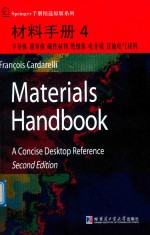图书介绍
材料手册 4 半导体 超导体 磁性材料 绝缘体 电介质 其他电气材料pdf电子书版本下载

- (美)卡达雷利主编 著
- 出版社: 哈尔滨:哈尔滨工业大学出版社
- ISBN:9787560344508
- 出版时间:2014
- 标注页数:656页
- 文件大小:29MB
- 文件页数:217页
- 主题词:材料科学-技术手册-英文;电器-电工材料-技术手册-英文
PDF下载
下载说明
材料手册 4 半导体 超导体 磁性材料 绝缘体 电介质 其他电气材料PDF格式电子书版下载
下载的文件为RAR压缩包。需要使用解压软件进行解压得到PDF格式图书。建议使用BT下载工具Free Download Manager进行下载,简称FDM(免费,没有广告,支持多平台)。本站资源全部打包为BT种子。所以需要使用专业的BT下载软件进行下载。如 BitComet qBittorrent uTorrent等BT下载工具。迅雷目前由于本站不是热门资源。不推荐使用!后期资源热门了。安装了迅雷也可以迅雷进行下载!
(文件页数 要大于 标注页数,上中下等多册电子书除外)
注意:本站所有压缩包均有解压码: 点击下载压缩包解压工具
图书目录
5 Semiconductors 455
5.1 Band Theory of Bonding in Crystalline Solids 455
5.2 Electrical Classification of Solids 456
5.3 Semiconductor Classes 457
5.3.1 Intrinsic or Elemental Semiconductors 457
5.3.2 Doped Extrinsic Semiconductors 458
5.3.3 Compound Semiconductors 459
5.3.4 Grimm-Sommerfeld Rule 459
5.4 Concentrations of Charge Carriers 460
5.5 Transport Properties 461
5.5.1 Electromigration 461
5.5.2 Diffusion 462
5.5.3 Hall Effect 462
5.6 Physical Properties of Semiconductors 463
5.7 Industrial Applications and Uses 463
5.8 Common Semiconductors 463
5.8.1 Silicon 463
5.8.2 Germanium 469
5.8.3 Boron 470
5.8.4 Other Semiconductors 471
5.9 Semiconductor Wafer Processing 471
5.9.1 Monocrystal Growth 472
5.9.2 Wafer Production 473
5.10 The P-N Junction 475
5.11 Further Reading 475
6 Superconductors 477
6.1 Description and General Properties 477
6.2 Superconductor Types 478
6.2.1 Type Ⅰ Superconductors 478
6.2.2 Type Ⅱ Superconductors 480
6.2.3 High-critical-temperature Superconductors 481
6.2.4 Organic Superconductors 482
6.3 Basic Theory 482
6.4 Meissner-Ochsenfeld Effect 483
6.5 History 483
6.6 Industrial Applications and Uses 485
6.7 Further Reading 485
7 Magnetic Materials 487
7.1 Magnetic Physical Quantities 487
7.1.1 Magnetic Field Strength and Magnetomotive Force 487
7.1.2 Magnetic Flux Density and Magnetic Induction 488
7.1.3 Magnetic Flux 489
7.1.4 Magnetic Dipole Moment 490
7.1.5 Magnetizability,Magnetization,and Magnetic Susceptibility 491
7.1.6 Magnetic Force Exerted on a Material 492
7.1.7 Magnetic Force Exerted by Magnets 493
7.1.8 Magnetic Energy Density Stored 493
7.1.9 Magnetoresistance 494
7.1.10 Magnetostriction 494
7.1.11 Magnetocaloric Effect 495
7.1.12 SI and CGS Units Used in Electromagnetism 498
7.2 Classification of Magnetic Materials 498
7.2.1 Diamagnetic Materials 499
7.2.2 Paramagnetic Materials 500
7.2.3 Ferromagnetic Materials 501
7.2.4 Antiferromagnetic Materials 503
7.2.5 Ferrimagnetic Materials 504
7.3 Ferromagnetic Materials 504
7.3.1 B-H Magnetization Curve and Hysteresis Loop 504
7.3.2 Eddy-Current Losses 506
7.3.3 Induction Heating 507
7.3.4 Sofi Ferromagnetic Materials 507
7.3.5 Hard Magnetic Materials 510
7.3.6 Magnetic Shielding and Materials Selection 512
7.4 Industrial Applications of Magnetic Materials 516
7.5 Further Reading 516
8 Insulators and Dielectrics 519
8.1 Physical Quantities of Dielectrics 519
8.1.1 Permittivity of Vacuum 519
8.1.2 Permittivity of a Medium 519
8.1.3 Relative Permittivity and Dielectric Constant 520
8.1.4 Capacitance 520
8.1.5 Temperature Coefficient of Capacitance 520
8.1.6 Charging and Discharging a Capacitor 521
8.1.7 Capacitance of a Parallel-Electrode Capacitor 521
8.1.8 Capacitance of Other Capacitor Geometries 521
8.1.9 Electrostatic Energy Stored in a Capacitor 522
8.1.10 Electric Field Strength 522
8.1.11 Electric Flux Density 522
8.1.12 Microscopic Electric Dipole Moment 522
8.1.13 Polarizability 523
8.1.14 Macroscopic Electric Dipole Moment 523
8.1.15 Polarization 523
8.1.16 Electric Susceptibility 524
8.1.17 Dielectric Breakdown Voltage 524
8.1.18 Dielectric Absorption 524
8.1.19 Dielectric Losses 525
8.1.20 Loss Tangent or Dissipation Factor 525
8.1.21 Dielectric Heating 526
8.2 Physical Properties of Insulators 526
8.2.1 Insulation Resistance 526
8.2.2 Volume Electrical Resistivity 526
8.2.3 Temperature Coefficient of Electrical Resistivity 527
8.2.4 Surface Electrical Resistivity 528
8.2.5 Leakage Current 528
8.2.6 SI and CGS Units Used in Electricity 529
8.3 Dielectric Behavior 530
8.3.1 Electronic Polarization 530
8.3.2 Ionic Polarization 531
8.3.3 Dipole Orientation 531
8.3.4 Space Charge Polarization 531
8.3.5 Effect of Frequency on Polarization 531
8.3.6 Frequency Dependence of the Dielectric Losses 532
8.4 Dielectric Breakdown Mechanisms 532
8.4.1 Electronic Breakdown or Corona Mechanism 533
8.4.2 Thermal Discharge or Thermal Mechanism 533
8.4.3 Internal Discharge or Intrinsic Mechanism 533
8.5 Electrostriction 533
8.6 Piezoelectricity 534
8.7 Ferroelectrics 534
8.8 Aging of Ferroelectrics 538
8.9 Classification of Industrial Dielectrics 538
8.9.1 Class Ⅰ Dielectrics or Linear Dielectrics 538
8.9.2 Class Ⅱ Dielectrics or Ferroelectrics 539
8.10 Selected Properties of Insulators and Dielectric Materials 539
8.11 Further Reading 542
9 Miscellaneous Electrical Materials 543
9.1 Thermocouple Materials 543
9.1.1 The Seebeck Effect 543
9.1.2 Thermocouple 544
9.1.3 Properties of Common Thermocouple Materials 545
9.2 Resistors and Thermistors 548
9.2.1 Electrical Resistivity 548
9.2.2 Temperature Coefficient of Electrical Resistivity 548
9.3 Electron-emitting Materials 552
9.4 Photocathode Materials 553
9.5 Secondary Emission 554
9.6 Electrolytes 555
9.7 Electrode Materials 556
9.7.1 Electrode Materials for Batteries and Fuel Cells 556
9.7.2 Intercalation Compounds 559
9.7.3 Electrode Materials for Electrolytic Cells 561
9.7.3.1 Industrial Cathode Materials 563
9.7.3.1.1 Low-Carbon Steel Cathodes 563
9.7.3.1.2 Aluminum Cathodes 563
9.7.3.1.3 Titanium Cathodes 564
9.7.3.1.4 Zirconium Cathodes 565
9.7.3.1.5 Nickel Cathodes 565
9.7.3.1.6 Mercury Cathode 565
9.7.3.2 Industrial Anode Materials 565
9.7.3.2.1 Precious-and Noble-Metal Anodes 568
9.7.3.2.2 Lead and Lead-Alloy Anodes 569
9.7.3.2.3 Carbon Anodes 572
9.7.3.2.4 Lead Dioxide(PbO2) 573
9.7.3.2.5 Manganese Dioxide(MnO2) 575
9.7.3.2.6 Spinel(AB2O4)-and Perovskite(ABO3)-Type Oxides 575
9.7.3.2.7 Ebonex?(Ti4O7 and Ti5O9) 576
9.7.3.2.8 Noble-Metal-Coated Titanium Anodes(NMCT) 578
9.7.3.2.9 Platinized Titanium and Niobium Anodes(70/30 Pt/Ir) 579
9.7.3.2.10 Dimensionally Stable Anodes(DSA?)for Chlorine Evolution 580
9.7.3.2.11 Dimensionally Stable Anodes(DSA?)for Oxygen 581
9.7.3.2.12 Synthetic Diamond Electrodes 585
9.7.4 Electrodes for Corrosion Protection and Control 586
9.7.4.1 Cathodes for Anodic Protection 586
9.7.4.2 Anodes for Cathodic Protection 587
9.7.5 Electrode Suppliers and Manufacturers 589
9.8 Electrochemical Galvanic Series 590